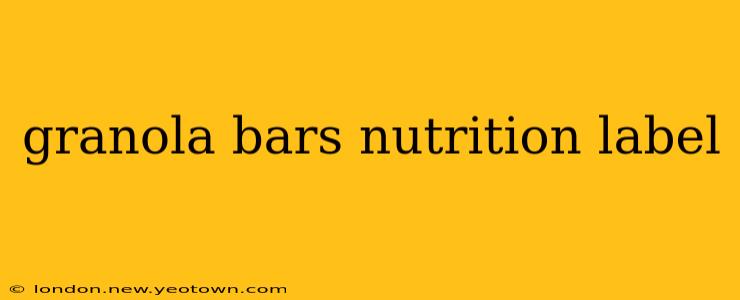Granola bars. The quintessential grab-and-go snack, a quick breakfast, or even a satisfying midday pick-me-up. But have you ever really looked at that nutrition label? It's a tiny window into a world of sugars, fats, and fibers – a world that can be surprisingly complex. This isn't just about calories; it's about understanding what fuels your body and how to make the best choices for your health. Let's dive in!
What are the key things to look for on a granola bar nutrition label?
This is the million-dollar question, isn't it? The nutrition label is your roadmap to understanding what you're consuming. Instead of just focusing on the total calorie count, let's break down the crucial elements:
-
Serving Size: This is the foundation. Pay close attention to the serving size and how many bars are in the package. Many people eat more than one bar at a time, significantly altering the total nutrient intake.
-
Calories: A general guideline, but consider calories in the context of the other nutrients. A high-calorie bar might be acceptable if it's packed with fiber and protein to keep you full.
-
Total Fat, Saturated Fat, and Trans Fat: Fat isn't the enemy, but moderation is key. Focus on reducing saturated and trans fats, which can negatively impact heart health. Unsaturated fats (like those found in nuts and seeds) are beneficial.
-
Cholesterol: Generally not a major concern in granola bars unless they contain significant amounts of animal products.
-
Sodium: Many granola bars are surprisingly high in sodium. Be mindful of your daily sodium intake, particularly if you're watching your blood pressure.
-
Total Carbohydrate, Dietary Fiber, and Sugars: This trio is crucial. Total carbohydrates show the total amount of carbs. Dietary fiber is your friend; it promotes digestive health and keeps you feeling full. "Sugars" indicates added sugars – the less, the better. Look for bars with a higher fiber-to-sugar ratio.
-
Protein: Protein is essential for building and repairing tissues. Choose bars with a decent amount of protein to keep you feeling satisfied and energized.
How many calories should be in a granola bar?
There's no magic number. The ideal calorie count depends on your individual needs and dietary goals. However, many nutritionists recommend aiming for bars in the 150-250 calorie range, especially if you're using it as a snack. Remember to adjust your overall calorie intake throughout the day accordingly.
What are the main ingredients in granola bars?
The ingredient list is your best friend. Look for whole grains like oats, nuts, seeds, and dried fruits as the primary ingredients. Avoid bars with excessive added sugars, high fructose corn syrup, or partially hydrogenated oils (a source of trans fats).
Are granola bars healthy?
The healthiness of a granola bar greatly depends on its ingredients. Some bars are nutrient-packed and can be part of a balanced diet, while others are essentially candy bars in disguise. Always check the nutrition label and ingredient list to make an informed decision.
How to choose a healthy granola bar?
It boils down to label literacy. Look for bars that:
- Prioritize whole grains: Oats, whole wheat, brown rice.
- Are lower in added sugars: Ideally, less than 5 grams per serving.
- Contain a good amount of fiber: At least 3 grams per serving.
- Offer a decent source of protein: At least 3-5 grams per serving.
- Have minimal processed ingredients: Avoid long lists of unrecognizable additives.
By understanding the information presented on the nutrition label and the ingredient list, you can navigate the world of granola bars and choose options that support your healthy lifestyle goals. Remember, reading the label is the first step to making conscious, nutritious choices.

